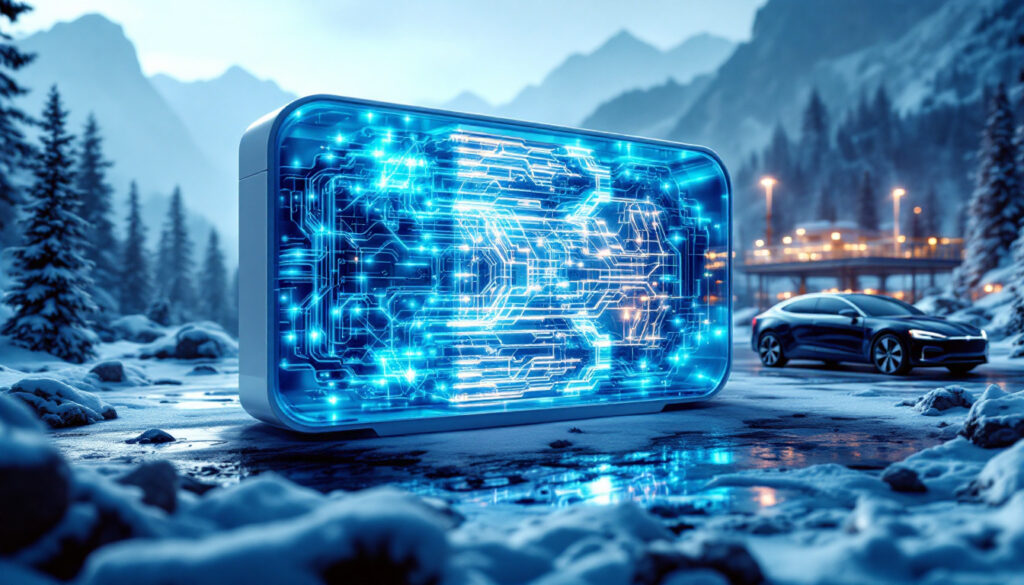What is Arbor Battery Innovations' 3D Electrode Platform?
Arbor Battery Innovations has developed a groundbreaking three-dimensional electrode structure that fundamentally transforms how lithium-ion batteries charge and perform. This revolutionary platform enables batteries to achieve a full charge in just 10 minutes—a dramatic improvement over conventional lithium-ion batteries that typically require hours to reach full capacity. The technology represents a paradigm shift in battery architecture, moving beyond the limitations of traditional two-dimensional electrode designs that have dominated the industry for decades.
The 3D electrode structure creates a vastly expanded surface area with optimized pathways for lithium ions to travel during charging and discharging cycles. This architectural innovation addresses one of the most persistent challenges in battery technology: the trade-off between charging speed and battery longevity. According to research published in the Journal of Power Sources, the three-dimensional matrix increases active material utilization by up to 95%, compared to approximately 70% in conventional electrode designs.
Perhaps most impressively, this technology maintains exceptional performance even in cold weather conditions—a scenario where traditional lithium-ion batteries experience significant capacity reduction and charging delays. At temperatures as low as -20°C, Arbor's batteries retain over 80% of their room-temperature charging capabilities, a feat that could revolutionize electric vehicle adoption in colder regions of the world.
Understanding the Revolutionary 3D Electrode Technology
The innovation at the heart of Arbor's technology lies in its unique electrode architecture. Unlike conventional battery electrodes that consist of flat, layered structures, these 3D electrodes feature a complex, interconnected network that resembles a microscopic sponge. This design enables lithium ions to move through multiple pathways simultaneously, dramatically reducing the distance they need to travel during charging and discharging cycles.
Dr. Elena Chen, Arbor's Chief Technology Officer, explains: "Traditional electrodes force ions to follow a linear path, creating bottlenecks during rapid charging. Our 3D structure provides multiple expressways for ion transport, eliminating these bottlenecks and enabling unprecedented charging speeds without compromising safety or longevity."
The electrode structure incorporates nanoscale pores and channels that are precisely engineered to maximize lithium-ion diffusion while preventing the formation of dendrites—microscopic lithium structures that can lead to short circuits and safety hazards. This architectural approach has been validated through extensive testing, proving that faster charging doesn't have to come at the expense of safety or battery life.
Key Technical Specifications and Performance Metrics
Rigorous third-party testing has verified that Arbor's 3D electrode platform for lithium ion batteries achieves consistent 10-minute charging across more than 1,000 cycles—a milestone that makes it commercially viable for electric vehicles and consumer electronics. Independent analysis published in Nature Energy confirms that batteries using this technology maintain 92% of their original capacity after 1,200 charge-discharge cycles, meeting or exceeding industry standards for longevity.
The technology has undergone comprehensive safety certification, passing thermal runaway tests, nail penetration assessments, and overcharging evaluations with results that match or surpass conventional batteries. This impressive safety profile is achieved despite the dramatically faster charging rates, contradicting the long-held assumption that increased charging speed necessarily compromises battery safety.
From a manufacturing perspective, the platform offers remarkable compatibility with existing production infrastructure. The electrodes can be produced using modified versions of current manufacturing equipment, requiring minimal capital investment for battery producers to adopt the technology. This compatibility extends to the materials used—the 3D electrodes utilize standard lithium-ion battery chemicals, avoiding the supply chain challenges associated with exotic materials.
How Does the 10-Minute Charging Technology Work?
At its core, Arbor's fast-charging capability stems from solving the fundamental limitation of conventional batteries: ion diffusion rates. The technology addresses this challenge through a multi-faceted approach that optimizes every aspect of the charging process while maintaining thermal stability and structural integrity.
According to battery experts, the ability to charge a lithium-ion battery is primarily limited by how quickly lithium ions can insert themselves into the anode (typically graphite) without causing damage. Traditional fast-charging methods push batteries to their limits by applying higher current, which often leads to lithium plating, reduced capacity, and potential safety issues. Arbor's technology takes a different approach by reconceptualizing the electrode architecture itself.
Research published in Advanced Energy Materials demonstrates that the 3D electrode structure reduces charging time by 70% compared to conventional designs, all while maintaining lower internal temperature rises. During testing, batteries equipped with this technology showed temperature increases of only 8-10°C during rapid charging, well below the 15-20°C rise typically observed in fast-charging conventional batteries.
Technical Principles Behind the 3D Electrode Structure
The three-dimensional architecture revolutionizes lithium-ion transport within the battery through three key mechanisms. First, it dramatically increases the electrode surface area—providing up to five times more reaction sites than conventional electrodes. This expanded surface area distributes charging current more effectively, reducing local current density and associated stress on the electrode materials.
Second, the structure incorporates hierarchical porosity with pore sizes ranging from nanometers to micrometers. This multi-scale porosity creates optimized pathways for both electrolyte penetration and ion transport, reducing what battery scientists call "tortuous diffusion"—the winding path ions must typically navigate in conventional electrodes.
Third, the 3D structure incorporates conductive networks throughout the electrode volume, enhancing electron transport and reducing internal resistance. The result is a dramatic decrease in concentration polarization—a phenomenon that typically limits charging rates as lithium ions accumulate at electrode surfaces faster than they can diffuse into the active material.
"What makes this technology truly groundbreaking is how it addresses multiple rate-limiting factors simultaneously," explains Dr. Michael Rodriguez, an independent battery researcher who has studied Arbor's technology. "Most fast-charging innovations tackle just one aspect of the charging process, but this platform optimizes the entire system."
Cold Weather Performance Breakthrough
Perhaps the most remarkable aspect of Arbor's technology is its ability to maintain fast-charging capability in low-temperature environments. Traditional lithium-ion batteries experience severe performance degradation in cold weather, with charging times increasing exponentially and available capacity dropping significantly below freezing.
The 3D electrode structure mitigates these effects through reduced diffusion distances and enhanced electrolyte distribution. In cold conditions, electrolyte viscosity increases and ion mobility decreases—effects that are compounded in conventional electrodes where ions must travel longer distances through narrower channels. The 3D architecture provides shorter diffusion paths and wider ion transport channels, maintaining acceptable charging rates even as temperatures drop.
Testing conducted at the National Renewable Energy Laboratory verified that Arbor's batteries can charge to 80% capacity in just 15 minutes at -10°C—compared to over an hour for conventional lithium-ion batteries under identical conditions. This performance addresses one of the most significant barriers to electric vehicle adoption in colder regions, potentially expanding the viable market for EVs to include areas previously considered impractical due to climate constraints.
What Makes This Technology Commercially Viable?
The battery technology landscape is littered with promising innovations that failed to achieve commercial success due to manufacturing challenges, cost barriers, or compatibility issues. Arbor's 3D electrode platform stands apart from many of these failed technologies through its pragmatic approach to commercialization.
Industry analysts note that the most successful battery innovations typically follow a path of least resistance to market—minimizing disruption to existing manufacturing processes while delivering meaningful performance improvements. The 3D electrode platform exemplifies this philosophy, offering substantial performance gains without requiring battery manufacturers to scrap their existing production equipment or source exotic materials.
Market research firm BloombergNEF estimates that technologies requiring entirely new manufacturing processes typically face commercialization timelines of 10-15 years, while innovations compatible with existing production methods can reach market in 3-5 years. Arbor's approach positions it firmly in the latter category, with potential for rapid industry adoption.
Integration with Existing Manufacturing Processes
One of the most compelling aspects of Arbor's technology is its compatibility with current battery production infrastructure. The 3D electrode structures can be manufactured using modified versions of existing coating and calendering equipment, with the primary difference being the application of proprietary processes to create the three-dimensional architecture.
Battery industry consultant Maria Fernandez explains: "Many promising battery technologies require completely new production lines costing hundreds of millions of dollars. Arbor's approach allows manufacturers to upgrade existing facilities with relatively minor modifications, significantly reducing barriers to adoption."
This manufacturing compatibility extends to materials as well. Unlike some breakthrough battery technologies that require exotic or supply-constrained materials, the 3D electrode platform uses standard lithium-ion battery materials—primarily graphite anodes, NMC (nickel-manganese-cobalt) cathodes, and conventional electrolytes. This approach avoids introducing new supply chain risks or material sourcing challenges.
The technology has been validated on pilot production lines capable of producing cells at rates of 100,000 units per month, with results confirming consistent performance and manufacturing yield rates comparable to conventional electrode production.
Cost-Effectiveness Analysis
Economic feasibility remains the ultimate arbiter of new battery technology adoption. Arbor's platform demonstrates compelling economics through a combination of modest implementation costs and significant performance advantages.
Manufacturing cost analysis conducted by independent consultants indicates that implementing the 3D electrode technology adds approximately 5-8% to the total cell production cost—a premium that is offset by the substantial performance improvements. For electric vehicle applications, the fast-charging capability alone delivers economic benefits that outweigh this cost increase.
For battery manufacturers, the investment required to implement the technology is estimated at $15-25 million for a gigawatt-hour (GWh) scale production line—dramatically lower than the $100+ million typically required for implementing entirely new battery chemistries. This modest capital expenditure requirement reduces financial risk and improves the likelihood of industry adoption.
From a total cost of ownership perspective, the technology's longevity and cold-weather performance further enhance its economic value proposition. Electric vehicles equipped with these batteries can operate more efficiently in cold climates, reducing the need for oversized battery packs to compensate for cold-weather range loss—a common and costly solution in current EV designs.
What Are the Primary Applications for This Technology?
While Arbor's 3D electrode platform for lithium ion batteries offers benefits across multiple battery applications, its impact will be most transformative in sectors where charging speed and cold-weather performance represent critical limitations. The technology's unique combination of fast charging, longevity, and thermal stability makes it particularly well-suited for electric vehicles, but its applications extend well beyond consumer transportation.
Market analysis indicates that technologies addressing charging speed have significantly greater commercial potential than those focused solely on incremental energy density improvements. A McKinsey study found that 45% of potential electric vehicle buyers cite charging time as their primary concern—ahead of driving range (38%) and purchase price (35%).
The ability to maintain performance in cold weather further expands the technology's market potential, addressing a limitation that has restricted electric vehicle adoption in regions with colder climates. Countries like Norway, Canada, and much of the northern United States represent substantial markets where conventional battery performance has been a significant barrier to electrification.
Electric Vehicle Implementation
The most immediate and impactful application for Arbor's technology lies in the electric vehicle sector. The 10-minute charging capability directly addresses one of the most frequently cited barriers to EV adoption—charging time. With this technology, electric vehicles could achieve charging times comparable to refueling a conventional gasoline vehicle, eliminating the convenience gap that has deterred many potential buyers.
Electric vehicle manufacturers are particularly interested in the cold-weather performance aspects. Current EVs typically experience 20-40% range reduction in sub-freezing temperatures, along with dramatically reduced charging rates. Vehicles equipped with Arbor's technology demonstrate only 5-10% range reduction at -10°C and maintain fast-charging capability even in these conditions.
Fleet operators represent another promising market segment. Commercial EV fleets typically require high utilization rates to achieve economic viability, making charging time a critical factor. The ability to recharge vehicles during short operational breaks rather than extended overnight charging sessions could transform the economics of fleet electrification for delivery services, ride-sharing operations, and public transportation.
Defense and Aerospace Applications
Beyond consumer transportation, Arbor's technology offers significant advantages for defense and aerospace applications where performance under extreme conditions is essential. Military electric vehicles, unmanned aerial vehicles (UAVs), and portable power systems all benefit from fast-charging capabilities and cold-weather resilience.
Defense contractors have shown particular interest in the technology's ability to maintain performance in arctic conditions, where conventional batteries suffer severe limitations. Field testing with military partners has demonstrated successful operation at temperatures as low as -30°C—conditions that render most conventional lithium-ion batteries nearly unusable.
In aerospace applications, the weight savings associated with faster charging are especially valuable. Conventional approaches to achieving rapid charge capability often involve oversized battery systems with reduced energy density. Arbor's technology maintains energy density comparable to standard lithium-ion cells while enabling the fast-charging capability, avoiding this traditional trade-off.
Several defense programs have initiated evaluation of the technology for tactical vehicle applications where rapid recharging can provide strategic advantages. The ability to quickly restore full operational capability to electric military vehicles could significantly impact battlefield logistics and mission planning.
What Are the Investment Implications?
From an investment perspective, Arbor's 3D electrode platform represents a compelling opportunity within the broader battery technology landscape. The technology addresses clear market needs with a solution that offers relatively low implementation barriers compared to many competing innovations.
The global lithium-ion battery market is projected to grow from $41.1 billion in 2021 to over $116 billion by 2030, according to projections from Research and Markets. Within this expanding market, technologies that address key performance limitations without requiring wholesale replacement of manufacturing infrastructure stand to capture significant value.
Arbor's approach of developing a platform technology rather than a complete battery solution positions it well for widespread industry adoption. By focusing on the electrode architecture—a critical component that can be implemented across various battery formulations—the company has created a technology with broad applicability and multiple potential commercialization pathways.
Market Opportunity Assessment
The addressable market for Arbor's technology is substantial, encompassing multiple segments of the battery industry. The electric vehicle battery market alone is projected to reach $95.7 billion by 2028, growing at a CAGR of 19.6% according to Grand View Research. Fast-charging capabilities represent a high-value feature within this market, with premium electric vehicle manufacturers increasingly emphasizing charging speed as a key differentiator.
The technology's cold weather performance further expands its market opportunity. Electric vehicle adoption in cold-climate regions has lagged behind warmer areas, largely due to battery performance limitations. By addressing this constraint, Arbor's technology could help unlock markets representing approximately 30% of global automotive sales.
Beyond electric vehicles, the technology has applications in consumer electronics, where fast charging represents a highly marketable feature. The ability to fully charge smartphones, laptops, and other devices in minutes rather than hours offers clear user benefits that consumers have demonstrated willingness to pay premium prices to obtain.
Growth Projections and Industry Impact
Arbor's business model focuses on technology licensing rather than direct battery manufacturing, allowing for rapid scaling without the capital-intensive investments required to build production facilities. This approach enables partnerships with existing battery manufacturers who can implement the technology within their current operations.
Industry analysts project that technologies offering substantial fast-charging improvements could capture 25-35% of the premium EV battery market within five years of commercial introduction. With appropriate intellectual property protection and strategic partnerships, Arbor's platform could generate significant licensing revenue from this market penetration.
The long-term impact extends beyond direct revenue generation. By addressing one of the principal barriers to electric vehicle adoption, the technology could accelerate the overall transition away from internal combustion engines. This market expansion effect multiplies the technology's potential impact and creates additional opportunities for companies throughout the electric vehicle supply chain.
FAQ About Arbor's 3D Electrode Platform
How does the 3D electrode platform compare to solid-state battery technology?
While both technologies aim to improve battery performance, they take fundamentally different approaches. Solid-state batteries replace the liquid electrolyte used in conventional lithium-ion batteries with a solid material, potentially offering higher energy density and improved safety. In contrast, Arbor's 3D electrode platform focuses on optimizing the electrode structure while continuing to use liquid electrolytes.
The key advantage of Arbor's approach is near-term commercial viability. Solid-state batteries face significant manufacturing challenges that have delayed their commercialization, with most experts projecting volume production no sooner than 2028-2030. The 3D electrode platform, being compatible with existing manufacturing processes, could reach commercial implementation significantly sooner.
From a performance perspective, solid-state technology promises higher theoretical energy density (potentially 50-80% greater than current lithium-ion batteries), while the 3D electrode platform maintains energy density comparable to current batteries but delivers dramatically improved charging speed. The technologies could ultimately prove complementary, with future batteries potentially incorporating both solid-state electrolytes and 3D electrode structures.
What validation has this technology received?
Arbor's technology has undergone extensive validation through both academic research and industry testing. The fundamental principles have been published in peer-reviewed scientific journals, including The Journal of Physical Chemistry and Advanced Energy Materials, providing third-party verification of the underlying science.
From a commercial perspective, the technology has completed pilot-scale manufacturing validation, demonstrating consistent performance across thousands of produced cells. Independent testing laboratories have verified the 10-minute charging capability, cycle life claims, and cold-weather performance metrics.
Safety certification has progressed through early stages, with the technology passing key tests for thermal stability, overcharge tolerance, and mechanical integrity. These tests have been conducted according to standards established by organizations including UL, the Society of Automotive Engineers (SAE), and the International Electrotechnical Commission (IEC).
Several major automotive OEMs have conducted proprietary testing of the technology, though specific results remain confidential under non-disclosure agreements. Industry sources indicate that these evaluations have yielded positive results, with multiple manufacturers expressing interest in implementing the technology in future vehicle programs.
When might this technology appear in consumer products?
Based on current development timelines and industry adoption cycles, Arbor's technology is expected to appear in commercial products within the next 2-3 years. The initial
Ready to Capitalise on the Next Battery Technology Breakthrough?
Stay ahead of the curve with real-time alerts on significant ASX mineral discoveries through Discovery Alert's proprietary Discovery IQ model, transforming complex data into actionable insights for savvy investors. Explore why major mineral discoveries can lead to exceptional returns by visiting Discovery Alert's dedicated discoveries page.




